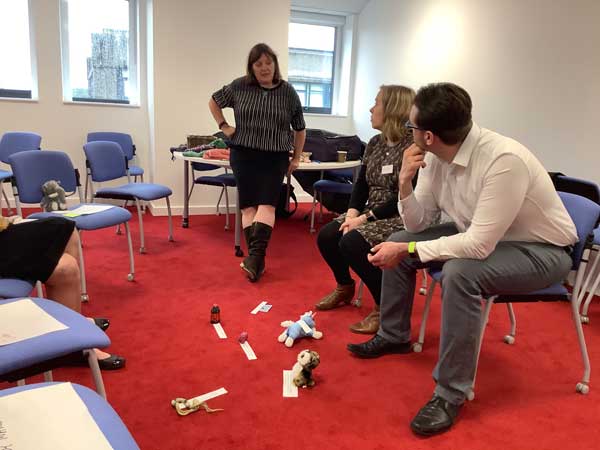Action Methods
REELER Road Map
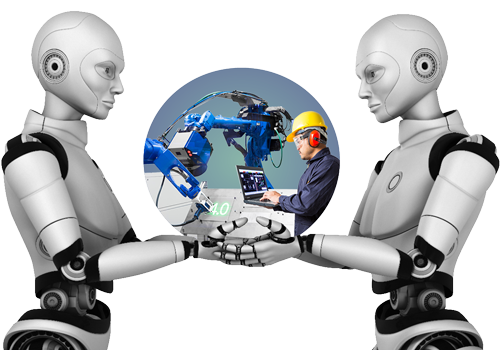

Explorative tools for interdisciplinary collaboration
REELER invited robot makers to take part in two types of role-based action methods to promote SSH-RRI collaboration. These are social drama ©REELER and sociodrama.
Action methods are visual and role-based approaches to individual and group work. The aim of testing these types of methods in REELER was to identify potentially useful tools to support interdisciplinary collaboration and to provide robot developers with a novel and collaborative tool for problem-solving techniques.
The REELER project has explored if robot makerss could use these types of action methods as tools to help gain insights into their work and related assumptions regarding human needs and societal concerns, in unconventional ways.
Assessment of social drama and sociodrama as tools in robot making
Given the novelty of the sociodrama method in robotics research, the REELER project involved a large degree of experimentation rather than merely application of the sociodrama tool.
Both methods have rendered positive results by facilitating interdisciplinary collaboration that allow for new perspectives on robot design and robot uptake to be explored. In that process, both tacit assumptions and reflected viewpoints among robot engineers and social scientists were called forth and debated.
Nonetheless, both methods also come with certain limitations. In the case of sociodrama, the dependency on the appropriate, professional specialist in sociodrama to facilitate the sessions has proven challenging. Moreover, the group composition also affects the outcome. Though the interdisciplinary composition enable certain explorations, it also hindered in-depth exploration to some degree. For those reasons, we cannot recommend sociodrama as an easily-accessible tool. Having said that, however, the method did yield positive results for collaborative learning, engagement, reflection and consciousness raising about the ethics of robotics.
See more about the beneficial outcome and challenges of social drama and sociodrama respectively below.
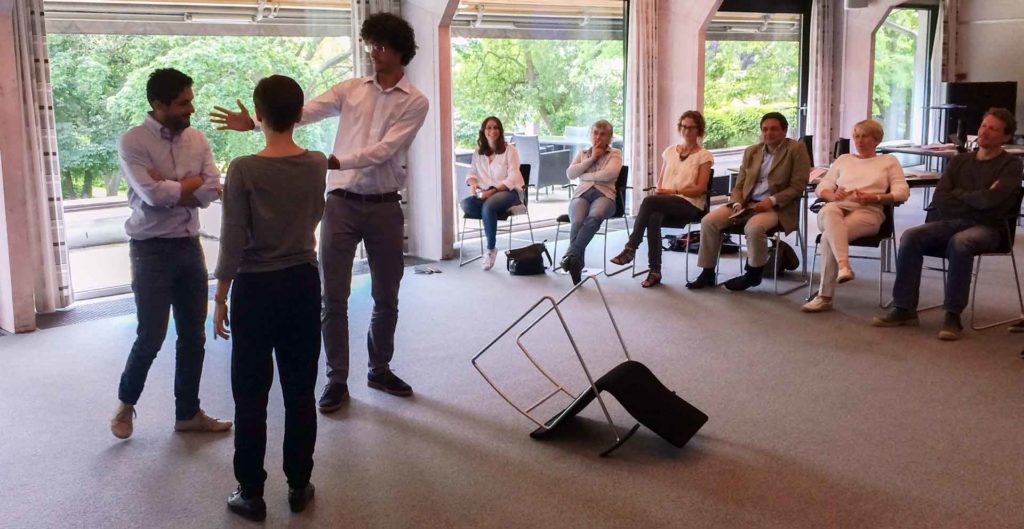

Social Drama in robotics © REELER
Social drama as a tool in robot development was developed by the REELER team with inspiration from Victor Turner’s work with ritual and theatre, persona and individual, role-playing and performing for a greater understanding of culture and its symbols (From Ritual to Theatre: The Human Seriousness of Play). We also drew on MacAloon’s work with social drama as a form of plural reflexivity in human social action (Drama, Festival, Spectacle: Rehearsals toward a Theory of Cultural Performance). REELER’s adaptation of social drama served as a method to explore role-play action within an interdisciplinary group. Through social drama, we can learn to speak as the other in a dialogical encounter with them, whether they be a person, a moral, a robot or ethical question. Thus, we used the potential of social drama to explore an issue from multiple perspectives without the constraint of reality to enable a deepening of understanding each other and the questions being examined in action.
Aim and ambition
With the ambition to increase collaborative learning between robot engineering and the social sciences and humanities (SSH), REELER introduced social drama as a methodological tool for interdisciplinary exploration in robotics.
The specific aim of this event, social drama in robotics, was to explore:
1) How REELER can help roboticists reflect on responsible ethics in relation to their robots
2) How social scientists may contribute with their expertise to the practices and expertise of robot developers.
Social drama on distributed ethical responsibility
15 persons, representing a mix of engineers and SSH-researchers, took part in this experimental session. The participants broke out into small groups, each of which devised a social drama scenario centered on their particular robot in relation to the day’s topic: distributed ethical responsibility.
The invited robot makers enacted the chosen parts of their own robots, which included both service and industrial robots with functions relating to sanitation, care, health, and manufacturing. Grouped with each robot were social scientists and other roboticists representing their areas of expertise, such as ethnographic research, ethics, learning, engineering, and innovation systems. This process allowed participants to engage in meaningful scenarios, and exploring each other’s field of expertise.
Themes elicited from the social drama scenarios
In the panel discussions following each social drama, a number of themes emerged. We present a selection of these themes below, along with some questions for further exploration.
- The robot What is a robot? Is it unique from other machines? Or is it just a tool? What is its role in relation to the human and to society? Do we need a uniform robot definition? And if so, what might it be?
- Economy & work What role does funding play in robot design? What are the economic impacts of implementing robots?
- Design What is involved in the design process? How is the user considered? When does the user participate? Can ethical responsibility be placed in design? Who do we consider to be users? Who else might we consider as users / affected stakeholders?
- Ethics What is ethical responsibility? How do we think about ethics in robotics? How can we translate ethical thinking from the individual to the work processes? When robots effect change in our physical social worlds, what are the ethical implications and how do these relate to responsibility?
- Distributed responsibility Where is ethical responsibility in a distributed technology? What is the implication of distributed ethical responsibility from a roboticist perspective?
- Collaborative learning What is learning? How does it tie in to design and implementation? How did we learn in this REP and how can we learn from each other in future? How do we establish common ground between the disciplines of robotics and SSH, but also bring robot developments closer to societal needs and concerns?
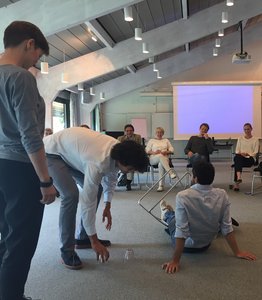

Participant feedback on social drama on distributed ethical responsibility
Social drama in a corporate research setting
Following the social drama session with the REELER project, one robot maker felt so inspired by the method that she conducted a similar session at KUKA’s Corporate Research Department.
Among the participants were nine purely technology focused colleagues, seven men and two female colleagues, with no social scientist background and a sceptical attitude towards roleplaying. The participants were introduced to the method and provided with a list of exemplary themes and concepts, similar to the ones presented and chosen at REELER’s social drama.
The participants were divided into three groups, with each group consisting of one robot and two concepts. The participants choosing a concept were asked to choose one that they can relate to. Some had already sympathised with a concept and others already knew they “wanted to be a robot”. All three robots had a “KUKA” connection.
The first, MAID, was the result of a former funded research project, the second, the KMR iiwa is an existing product, and the third, the REFILLS Scara is the demonstrator in a current H2020 research project.
Themes and robots explored in the corporate research setting
Scenario | Robot | Concept 1 | Concept 2 |
1 | Interactive MAID | Scepticism | Autonomy in daily life |
2 | KMR iiwa | Communication | Ethics |
3 | REFILLS Scara | Safety | Future Employment |
Evaluation of social drama in corporate research
As noted in the REELER working paper 5 “Social Drama: An experiment in the Corporate Research department of an industrial robot company”, the method worked similarly with an interdisciplinary group of social scientists and robotics engineers and a mono-disciplinary group of engineers.
Yet, in her analysis of the two social drama sessions, Bender notes the most obvious difference is that in the interdisciplinary social drama session, the concepts were played by social scientists, who enacted a concept from a familiar field. In the Corporate Research experiment, the participants were all engineers and choose concepts with which they could identify most. Therefore, it can be said that the educational background and ability to fully grasp what stands behind the chosen concepts will also influence the play and the discussions afterwards. This, Bender notes, must not be seen as a negative point, but it stresses that it will influence the role-playing and discussion.
In both groups, the method of social drama led to experiences and debates that would otherwise never have happened. Bender’s overall evaluation of social drama was that the “method [is] especially valuable when it is used to approach a new field or topic, which might be controversial but needs to be evaluated from different perspectives. Especially the discussions after each short play proved to show even further insights. I could also imagine that this method proves valuable for the evaluation of new stakeholder groups and their issues with a new technology” (Bender, p. 10, 2019)
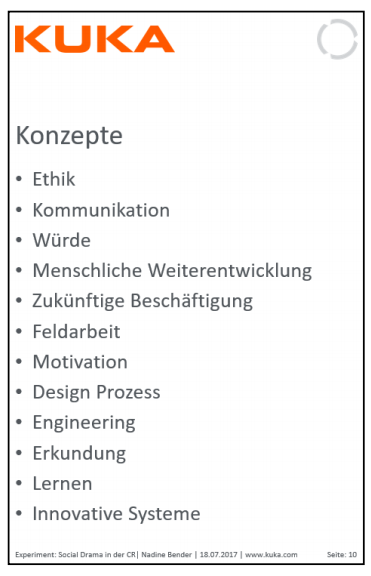

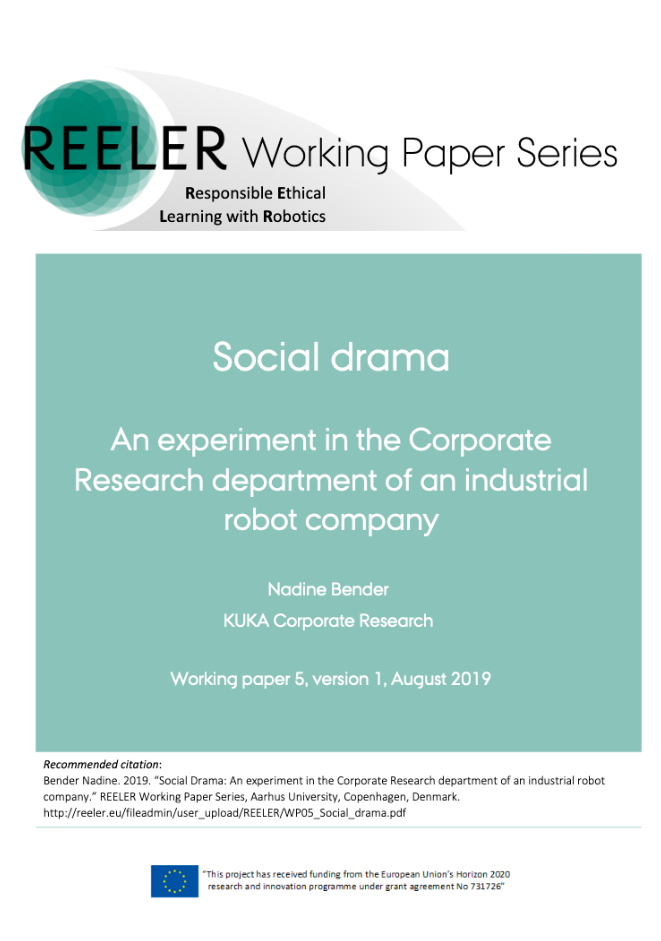

Read more about the experiences in KUKA corporate research in the working paper Social Drama
What is sociodrama?
Sociodrama is a mixed methodology combining sociology, psychology and drama to explore issues in social groups. It was originally developed by a Romanian sociologist and psychotherapist, Jacob L. Moreno. It is a skilled methodology that requires a trained practitioner. Sociodrama is not acting in any conventional sense as it is the ‘spontaneity of the moment’, the actual lives, situations, concerns, issues, and fantasies that are experienced by people. The ‘sets’ are created in the moment, the participants decide the meanings, and use props (that can be of any form) to stand in for ideas, institutions or parts of self and others. Sociodrama is a mechanism to introduce spontaneity into how people solved problems. In this sense, sociodrama is a consciousness raising tool, and a tool for action in people’s lives. The insights gained through rehearsing, role-reversal, and hidden voice activities allow people to express acts of their lived lives in new ways.
Moreno used the metaphor of the atom as a way to think about a person and their connections with others and coined the term ‘social atom’ to describe how individuals express their relationships with others indicating that individuals have varying degrees of relatedness and interest in others (Moreno 1947: 287). This is important to note in bureaucratic societies where decisions about others are depersonalised, yet they may have personal impacts, such as the making of robots, and the potential ethical issues this produces such as potential loss of jobs, or isolated working practices. Robots that will impact on those that have not created them. The role of ethics should be to balance these different agents and give them a voice in the process.
When has sociodrama been used?
Sociodrama has been used, for example, to help teaching new learnings styles in classrooms (Michel and Hatcher 1972), as a therapeutic technique with children with emotional difficulties (Creekmore and Madan 1981); as a method to improve race relations between different ethnic groups (Moreno 1943). More recently, it has been used as a method to help with conflict resolution (Kellermann 2007), promoting language skills (Rajapaksha 2016) and training in business administration (Novaes et al. 2014). As a method, its usefulness comes from its core philosophy which is focused around people and their relationships with others, and hence holds the potential of facilitating collaborative learning.
We proposed to explore if roboticists could use sociodrama as a tool to help them gain insights into their work, perhaps in ways they had not thought of, and had no other opportunity to arrive at an outcome that could be developed by the methods of sociodrama.
Sociodrama I: On assumptions in robotics
REELER’s sociodrama on assumptions in robotics was also conducted by an interdisciplinary group, this time consisting of six robot makers and seven SSH-researchers bringing the expertise of robot engineers in developing and implementing robotic technologies together with the empirical findings on social and ethical effects from REELER’s ethnographic research and macro-economic impact analyses.
The overall questions that initiated the collective exploration were:
- Why develop robots?
- What is our point of reference when designing robots?
REELER had invited the professional sociodramatist Valerie Monti Holland will help us consider how we might better understand the assumptions on which we design robots and the resulting impact of robots in society.
The group was invited to participate in sociometry and mapping out relationships. Mapping out relationships in a team is vitally important and normally this is done with the production of a two-dimensional chart. In this case, the space in the room was used as the canvas in which to map out the significant actors in the actors working relationships.
Themes elicited from the sociodrama session
- Why make robots? Robots are developed to solve a problem, but often human environment must adjust/change to meet the needs of the robot for the robot to work. Is that problematic? Is there a limit to how much the environment/human should adapt/change?
Is the robot always the solution and how much do we look into alternatives to the robot? - Imaginaries/exaggerating robots’ capabilities Robots are often presented as functioning much better (sometimes by drawing on sci-fi) than in reality due to PR reasons. Is this problematic? Do we give the general public a representative impression of robots’ actual capability?
- Self-reference To which degree do I refer to myself (e.g. body size, cognitive ability or social preferences) in designing the robot?
Though most agreed the day was enjoyable, this sociodrama session was not as well received by most of our guests as the previous social drama. Unfortunately, the sociodramatist was not able to hold the group’s focus and consequently the session did not lead to revealing any significant insights about assumptions in robotics, We took this as a learning experience and realized that factors such a group composition and dynamic within the group and between the group and the sociodramatist highly influence the outcome of using this tool.
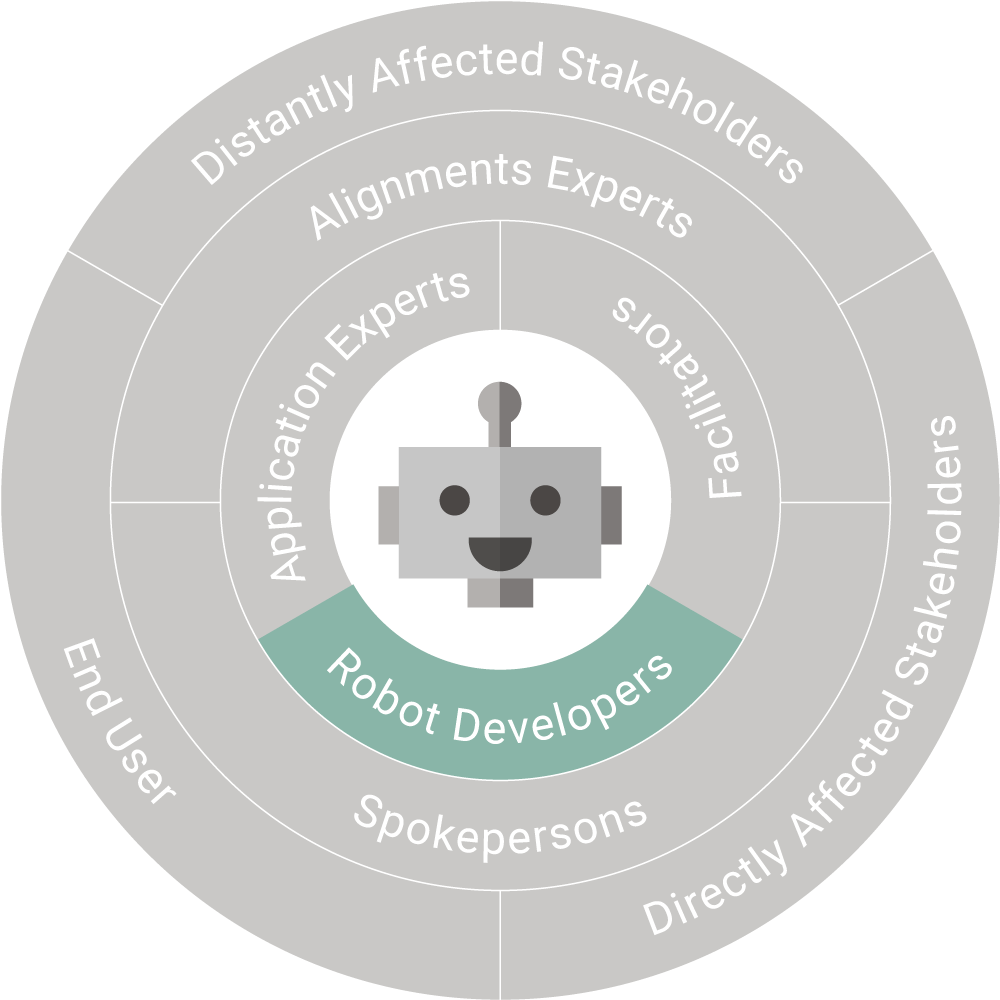

Deltagere i Sociodrama:
Robot Makers
SSH-researchers
Sociodrama II: On ethics and economic sustainability
At this session, participants explored one overall question:
“How can ethical practice and considerations be genuinely useful to people working in the robotics industry who want to both contribute to social development and make a profit at the same time?”
The majority of the invited participants were CEOs and company employees from robotic businesses.
Focus thus shifted away from academics to business. Themes that emerged from the sociodrama explored how business ethics was sometimes at odds with academic ethics. The companies believed that robots were an inevitable part of the business sector, and that while jobs might be lost, other jobs would be created. There was also an issue around profit. For businesses, profit is ethical. It is not unethical to make a profit, to develop a business or to build a good life. This can sometimes seems at odds with academics who are paid by the public purse and their livelihoods are not threatened in the same way that a business owner’s might be threatened.
Sociodrama III: Roboticist-driven theme
With the aim of increasing interdisciplinary collaborative learning through sociodrama, the two first sessions involved at least seven robot makers, plus the project team. Often, the REELER team outnumbered our invited participants. At the last sociodrama experiment, we decided to invite a team of a researchers in robotics and artificial intelligence from Loughborough University. Here two REELER project members acted as assistants to the professional sociodramatist.
Exploring ethics and collaboration with partners
Participants were given the options of deciding the questions to explore, and they decided to explore ethics in robotics and AI with special focus on questions about ethics and collaboration with other partners.
The sociodramatist introduced the methodology to the group and explained how it would be used. Sociodrama is not about ‘acting’. It is about trying to uncover the different actors involved in a social process (sociometry), and discovering through action what the actors can and cannot do.
As the sociodrama developed, engineers took on roles of funding organizations, the public, and even aging members of the public. The role of grandmother was taken by an engineer who was speaking on behalf of her own grandmother. She was a targeted end-user of some of the robots the robot makers would produce in the lab and yet a richer understanding of the difference in experience is not well understood.
Contrary to social drama, no roles were assigned to any robot makers. The robot makers created the roles, and acted them out, taking on different ones and experimenting
with different roles. Moreover, the robot makers started to include family members, such as the ageing or very young, when they were taking on different roles. This is because robot makers are not outside of their own social relationships, particularly meaningful intimate relationships, and because of this can also bring insight into their own processes.
In this scenario, the participants gained an understanding of what it might mean to develop technology for a section of the community that has not grown up with technology.
Does increased technology lead to social isolation?
In another scenario the robot makers explored the concern that increased technology can lead to social isolation, yet the robot maker initially failed to understand this. A robot maker produces robots in a lab surrounded by people, but the intended recipients of these technologies might have fewer social relationships. These often overlooked experiences need to be addressed when developing robots for the aging population.
Evaluation
This session received the most successful feedback of the three uses of sociodrama in the project. It was led by robot makers using a trained sociodramatist identified and appointed by the REELER team.
At all the scoiodrama and the social drama sessions, some participants felt anxious about the method and about expressing themselves in unfamiliar ways. Though this skepticism was soon replaced by enthusiasm, it may prove to be an obstacle for future usage without the right argumentation and motivation for engaging in this type of action method.
